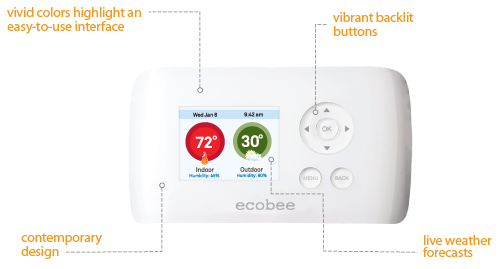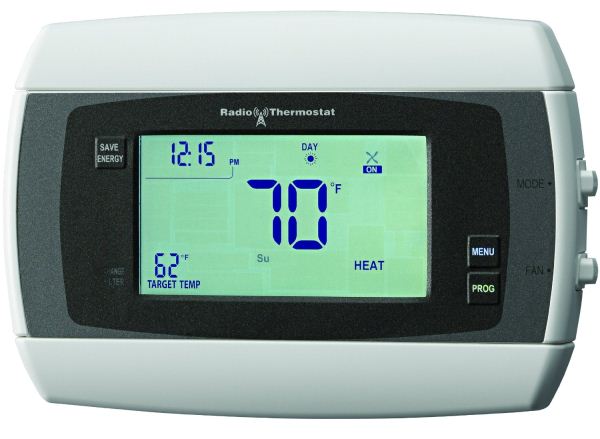Home Automation and the 'Internet of Things'
by Ganesh T S on October 4, 2012 10:30 AM EST- Posted in
- Gadgets
- Home Automation
- Wi-Fi
The Nest thermostat received quite a bit of attention from the press for its sleek industrial design and features. It was the first such product to receive widespread press coverage. In addition to being a thermostat which can be controlled over Wi-Fi, it also maintains energy history and is advertised as a 'learning' thermostat. These type of value-add features justified the original introductory price of $250. The first generation Nest became very popular amongst consumers and the second generation version with updated hardware and compatibility was launched recently.

Nest, however, was far from the first device to enable thermostat control over Wi-Fi. As long as the 'smart learning' features are not needed, there are plenty of cheaper options available. Radio Thermostat's Wi-Fi enabled products (along with iPhone and Android apps) have been around since 2010. Radio Thermostat’s offerings can be accessed through well-documented APIs. This means that tech-savvy users can roll up their own control mechanism without being at the mercy of the iOS or Android app. Home Depot's 3M Filtrete 50 and the Homewerks CT-30 are rebadged versions of Radio Thermostat's offerings.
These units are cheaper than the Nest, though self-installation might be challenging for the average consumer. Other options for Wi-Fi / network enabled HVAC thermostats include the LockState Connect LS-60i WiFi Internet Programmable Thermostat. and the ecobee Smart Si / Smart Thermostat.

My colleague, Brian Klug, has been using the Nest thermostat for a number of months now, and he is a big fan of the device. GigaOM, while heaping praise on the device, does point out some issues with it in the context of a smart home. Being a standalone device, it can’t be controlled over the same interface as other HA components. While the review does recommend the Nest to people who currently have no HA system installed, I fear that the device would lead consumers down the path of a walled garden similar to what Apple has created in the computing landscape. To elaborate on this, consider the fact that the APIs for Radio Thermostat’s offerings are well documented. On the other hand, Nest refuses to provide similar details for their device. In fact, users have done some snooping to discover some of the bits and pieces. On the whole, the lack of official API documentation makes the whole scheme appear very complicated. In a larger sense, HA is about control as well as building a smarter and more efficient ecosystem. While Nest succeeds very well in the latter, we hope it will also integrate well with other HA devices.
Due to the closed nature of the Nest system, third-party developers may not find enough incentive to control it along with other Wi-Fi enabled HA components over a single interface. It is a pity that the lack of slick marketing and an attractive industrial design have relegated consumer-friendly devices such as Radio Thermostat’s offerings to a niche when compared to closed systems such as the Nest. Hopefully, as tech-savvy readers, we consider the bigger picture before choosing any HA device.
Coming back to the thermostats, we find that Radio Thermostat offers models with ZigBee or Z-Wave modules instead of Wi-Fi also. The thermostat itself is protocol-agnostic because of its support for U-SNAP bridges. Nest, on the other hand, went the non-standard route by integrating both Wi-Fi and ZigBee radios within the device itself. A look at the pricing of various U-SNAP modules online indicates that the Wi-Fi module costs around $10 more than the ZigBee and Z-Wave modules. However, Wi-Fi modules have the volume factor going in their favour. A downward movement in the pricing can be expected as multiple silicon vendors compete against each other in the same space, as outlined in the previous section.











54 Comments
View All Comments
at80eighty - Thursday, October 4, 2012 - link
I have been poking around very recently to check out articles about this very topic, and wouldn't you know, you guys do something about it. thanks for the read.is this something you could be exploring as a series of articles? maybe something every few months; would love to know more in depth info esp. DIY stuff.
slickr - Saturday, October 6, 2012 - link
How is this awesome? Its 1984 on steroids. If you don't think government isn't going to use this to spy on your 24/7 and turn you into a mindless slave then you don't know history.Basically what you eat, what you drink, which appliances you use, how you dress, who you with, etc... will all be public for governments or hackers to get a hold of.
I think this is ridiculous, its bad, its negative, its Orwellian, its NAZI Germany like, its Brave new world like.
Axedall - Sunday, October 7, 2012 - link
How exactly do you think a government would use information like this? What are you eating that would anyone would be interested in? Babies? Are you dressing yourself in radioactive waste?And what makes you think that this information isn't available to pretty much anyone who wants it anyway? Do you use a credit card? Do you have a bank account (other than off shore)? A membership card for any kind of store? Unless you are using cash for every transaction you make, they are all being recorded and tracked. Not likely by the government, but certainly by corporations who will use it to tailor marketing strategies.
I'm surprised you are even using the internet. You realize that every website you visit can be tracked as well as your location don't you? Quick, better crawl back under a rock before 'they' find you!
As an aside... great article and thanks for providing information on emerging technology like this. Maybe some coverage on security issues would be a good idea, however, as this seems to be a pretty big concern for a number people. Admittedly, if I can control electrical appliances in my house remotely from a smart phone, someone else potentially could too.
rangerdavid - Sunday, October 28, 2012 - link
The only way you can prevent this from happening is by using this tinfoil. Wrap it around your head.Yes, just like that, but you missed the area covering your mouth.
There, better. :)
Violated - Tuesday, September 3, 2013 - link
Wow, I wish I would have read this last year! Slickr hit the nail on the head. I had Night Owl surveillance cameras outside my home and all new appliances and a new furnace, as well as a fully formally monitered security system. My ex while living here allowed access and set up basically a home I had no privacy, control or in reality ownership of. To make matters worse she was an especially vindictive woman and made me listen to unpeakable things via a RPC 2700/Ubuntu network she had secretly set up!!!I'm just finally figuring it all out, thankfully I'm still alie and can prove all the crazy things she's done.
DaveLessnau - Thursday, October 4, 2012 - link
And I'll bet that all these Home Automation vendors will put just a bunch of effort into hardening their products so that the fine people of our society won't hack our houses and turn our lives into living nightmares.Right.
Heck, they don't even harden medical devices. For that matter, they don't harden cell phones (which have turned into the core of people's lives).
DanNeely - Thursday, October 4, 2012 - link
If wifi wins the standard war anyone who has half a clue should be able to use WPA and a strong password to secure their HA systems. Granted the half clue needed to do so is a relatively high bar; but the clueless will break any other protection system too.k2_8191 - Thursday, October 4, 2012 - link
Agreed.I will never buy such network-enabled appliances.
I don't want to see my house flooded by hot water of a badly-designed spa :(
ntspam - Friday, October 5, 2012 - link
You can buy flood and freeze sensors that alert your phone. By the way you can pick and choose what you automate.aruisdante - Thursday, October 4, 2012 - link
Even if vendors do nothing, it's as secure as any home WiFi network is. All you have to do is enable WPA2 and its unlikely that anyone that would care is going to be able to get into your network.